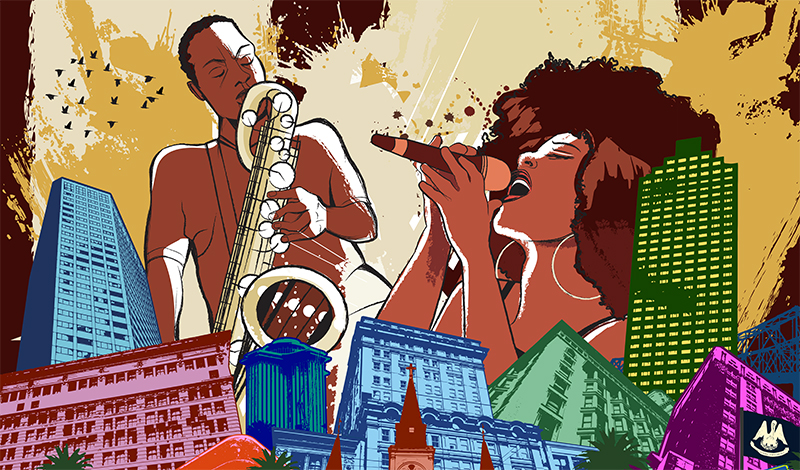In March 1974, Ikeda Sensei made his 10th visit to the United States. He had planned to travel to six U.S. cities and South America. On March 12, however, trips to New Orleans and Panama were added at a moment’s notice, affording him one more opportunity to encourage the members overseas.
To mark the 50th anniversary of Sensei’s visit to New Orleans, Living Buddhism chronicles his efforts through the recollections of the members who were present.
On March 15, members from several southern states surrounding Louisiana caravanned to New Orleans, many with hours’ notice, to attend a general meeting with a Buddhist leader who many had only encountered through publications and books.
As Ikeda Sensei entered the meeting, what they witnessed was a portrait of humanity writ large—not a religious figure on high but someone who was concerned for their happiness and led by example. Sensei went among the members, shaking hands and having heart-to-heart exchanges. He said to the 350 gathered before the official meeting began: “No matter where you go in the journey of life, my heart is always with you.” At that meeting, he named the participants the Happiness Group. Fifty years on, it’s a name whose meaning continues only to deepen with time.
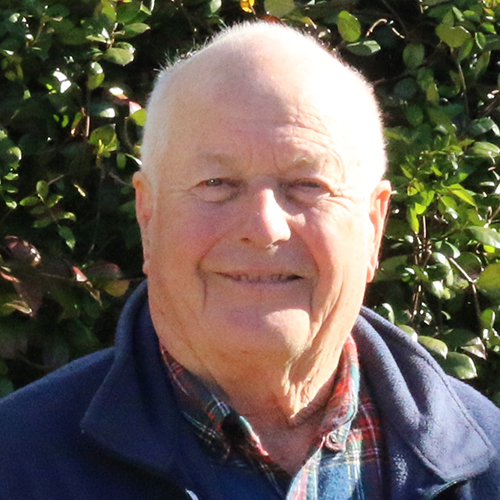
Paul Benham (Folsom, Louisiana): I was the young men’s division leader for the chapter that included New Orleans. On March 13, I just got home from work when my chapter men’s leader called and said, “Don’t go anywhere.” I asked, “Why not?” and he said, “Just don’t go anywhere. … Actually, why don’t you start chanting.” I can’t remember if I did, but in about an hour, he called back and said: “Come to the Marriott. Bring your suit. And bring all the young men you can find.” I found three or four guys and drove them to the Marriott. When we got there, we were told that Sensei would be coming in the next evening. We started booking hotel rooms, renting transportation and searching for a meeting place. A meeting with the chancellor of the University of New Orleans (UNO), Homer Hitt, was scheduled for March 15. In the midst of all the preparations, we were calling the members to tell them about the meeting.
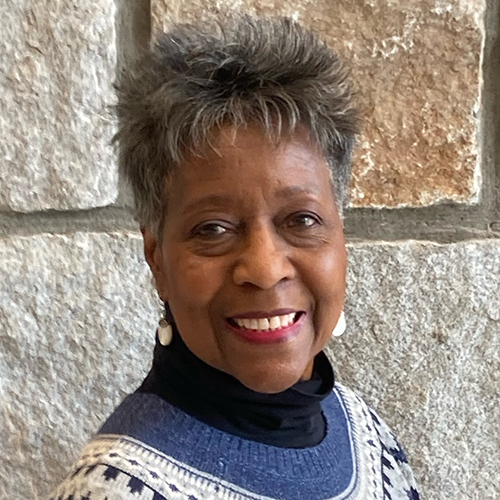
Dori Scales (Ellenwood, Georgia): My husband and I were newly appointed Peachtree District leaders. We received a call at 3 or 4 a.m. from our chapter leader telling us Sensei was going to be in New Orleans and we should let everyone know as quickly as possible. With the help of the group leaders, we called all of the members. About 10 of us formed a caravan for the eight-hour drive from Atlanta to New Orleans. We were all so excited! No one complained.
Sensei arrived in New Orleans on the evening of March 14. The following morning, at 11, he met with UNO Chancellor Homer Hitt, who had founded the university in an abandoned naval air station at a time when New Orleans was the largest U.S. city without a public college.
After Sensei and Mr. Hitt exchanged school mementos, Sensei presented the chancellor with a Soka University medal. They then began a frank, hourlong discussion concerning education, during which Mr. Hitt called education one of the most important issues of the 21st century and spoke about the various problems that U.S. universities faced. To be sure, when UNO opened its doors in September 1958, it was the first racially integrated public university in the South.
Sensei shared that through his global travels he had discovered that those same challenges were being faced by universities worldwide. And when Sensei suggested that an international organization of educators be established, modeled after the United Nations, Mr. Hitt enthusiastically agreed.
Afterward, Sensei strolled around the UNO campus. Spotting a few students, he asked them if they could sit down and talk.
Paul Benham: He just started talking to these kids, these college kids that were walking by. Next thing you know, he’s sitting down on the grass, and they’re having a discussion. Sensei was in a suit and had an interpreter and photographers. Do you know how hard it is to get college kids to talk to you? Especially then, they were so cynical about everything. But Sensei could really talk to anybody anywhere about anything. They were just drawn to him. It blew my mind to see it.
After his visit to UNO, Sensei went to New Orleans City Park. He sat with several members near a pond where ducks were swimming. He asked whether they knew what the ducks were doing when they pecked at their feathers.
Sensei explained that ducks were using their beaks to secrete an oily substance to coat their feathers, making needed preparations to reenter the water. In the same way, he said, it’s important to prepare before taking action. When it comes to SGI activities, for instance, we don’t do them first and then prepare for them afterward. He asked the youth to prepare in detail before taking action with the awareness that defeat would be inevitable otherwise.[1]
A Meeting With Their Mentor
Later that day, members from seven states— Louisiana, Tennessee, Arkansas, Georgia, Florida, Mississippi, Alabama and Kentucky—converged at the UNO’s Business Administration Building for a general meeting. For many of them, it was their first time meeting their mentor, and many had driven a significant distance to do so. Sensei entered the meeting venue at a little past 6 p.m., more than 30 minutes before schedule, and the room erupted with joyous energy.
Sensei spoke for nearly an hour about the connection between life and faith, based on profound Buddhist principles expressing the universal Law of life. He focused on the important and inescapable issues of birth, sickness, aging and death, and the need for our Buddhist practice.
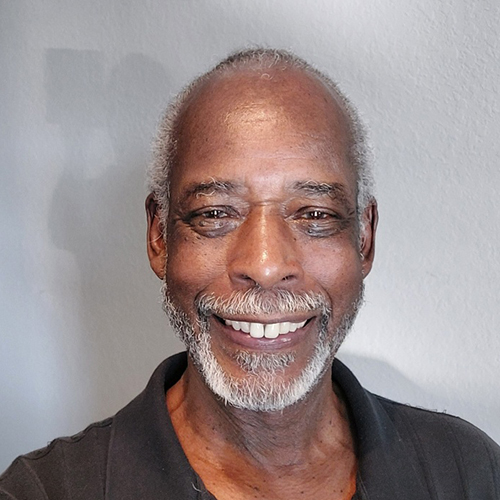
Sam Harris (St. Petersburg, Florida): I had been a member for only 18 months when we had the opportunity to see Sensei in New Orleans. I was a 24-year-old Vietnam veteran with a wife and two kids. Coming back from a combat zone, I was left angry, confused and frustrated. But at my first Buddhist meeting, they were talking about world peace, and that really resonated with me. So I was studying whatever I could get my hands on by Sensei in the first year-and-a-half of my practice.
I remember two things very vividly. The first was the energy and power that I felt from Sensei’s presence.
And when he came in, after shaking hands with everyone, he got to the stage, and all of the leaders were discussing something. I was wondering, What’s going on? And the next thing you know, they brought the table down from the stage, onto the floor. Sensei said he wanted to be closer to us. That really impressed me. He was so humble. He said he wanted to be on the same level as all of us.
The second thing I remember is he talked about the oneness of our life and the universe. And I was fascinated. I remember thinking, This is the wisest person I’ve ever known.
‘No matter what happens, please become happy.’
Sensei discussed the process of birth, aging, sickness and death, while relating it to the unavoidable issue of karma. He delved into the rhythm intrinsic in the unity of human beings and the universe, and articulated an understanding of life and the means to transform it that not even the highest fields of learning, including science, economics, art and culture, were able to offer. He said that people can live most humanely by rooting themselves firmly in the soil of reality.
He compared the cycle of life to a vertical axis, while positioning individual life on a horizontal axis, with its myriad changes in the dimensions of time and space and infused with the eternal aspect of life itself.
As a specific example, Sensei explained that human beings and the natural environment are one and inseparable. Commenting on Nichiren Daishonin’s writings, he observed, with humor at times, that the Mystic Law is the fundamental energy behind the harmonious fusion of the universe and human beings and human beings and nature. He urged everyone to be “suns of New Orleans” who are the greatest allies to those who tragically live without awareness of this Mystic Law, the limitless law of life.
“The Gohonzon we face every morning and evening is a miniature expression of life itself that includes all phenomena in the universe,” he said. “Employing this medium—which distills this fundamental rhythm [of life and the universe] and embodies its wisdom—fully activates our life, allowing it to merge and pulsate vibrantly with the boundless rhythm of the universe.”[2]
There are countless particles, large and small, scattered throughout the expanse of the cosmos. Many, such as atoms, are so minute that they are not visible to the naked eye, but their structures were discovered and deduced by science. Similarly, Sensei said, the sublime principle that gives expression to life is invisible, but it exists without question.
He said that those present are like scientists who have discovered this sublime principle of life and are showing proof of its efficacy while seeking to lead all people from suffering to happiness. He concluded his guidance by praising them as noble emissaries of the Mystic Law who are pioneering the way for humanity.
In comments that followed, he said that because it is the ultimate life philosophy, it may be difficult to grasp by listening to this short explanation. However, he said, nothing would bring him greater joy than if his words helped everyone gain conviction and serve as a source of encouragement for their lives into the future.
Sensei honored those who had gathered that day by naming them the “Happiness Group,” urging them to always advance kosen-rufu in solid unity together with him. His proposal that the commemorative photos from this gathering be preserved for eternity in the Kosen-rufu Memorial Hall in Japan was met with thunderous applause.
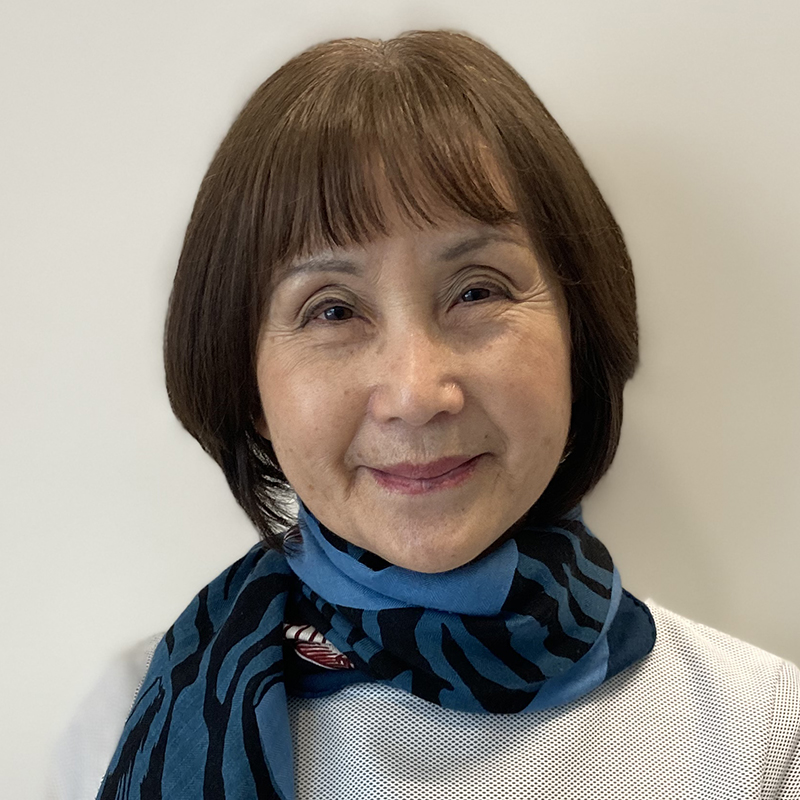
Yoko Simpson (Atlanta, Georgia): I moved to the States from Japan in February of 1973, and I was struggling in every aspect of my life. I was really suffering because of my inability to communicate and lack of knowledge of the culture.
When Sensei named us the Happiness Group, I was so excited. I thought he gave me a certificate to become happy. I felt like he guaranteed that I would become happy. After the meeting, he shook my hand. He told me: “You are doing great. I’ll be back to see you again.”
When I got home, I was so excited! I am going to become happy! I thought. I believed my situation would change immediately. It didn’t, and I started getting discouraged. I asked myself what it meant to be in the Happiness Group but to be struggling so much. Since I had been a Soka Gakkai member since I was 6, I knew I couldn’t be defeated. I had to experience winning through fighting for my life and kosen-rufu. I realized that being in the Happiness Group meant to become happy and to help others become happy. That is the mission of the Happiness Group.
Each individual had a different circumstance when meeting Sensei in 1974, but everyone left with a determination to fight for kosen-rufu. They carried through on their determination, and that built the foundation for kosen-rufu in the South.
Fifty years later, I feel a responsibility to become living proof and to proclaim unsurpassed happiness! I now know that there is no despair. There is no giving up or compromising. There is no such thing with faith in the Gohonzon.
Sam Harris: When he named us the Happiness Group, I was immature. I was proud, but I felt like I was somehow better than others, that I had a special right to be happy. That was my arrogance.
I’ve come to realize that the name is a badge of honor—a responsibility to enable everyone to become happy.
I’ve been practicing for over 50 years now, and stuff still goes on. But how do I feel while I’m going through whatever it is? I can honestly say that I’m at a state now in my life where I don’t get bent out of shape. I have the foundation in faith to view obstacles for what they are. Nothing shakes me anymore. I live confidently every day.
Now I think, If I live 10 years more, I can financially contribute to the SGI this much, and if I live 20 years more, I can contribute this much. I’m also participating in the Millennium Fund,[3] so I can contribute even after I’m gone. Working for kosen-rufu is the source of my greatest joy.
Toward the end of the guidance meeting, a commemorative photo session took place with all the children who were there. Like a gentle father, Sensei helped each child onto the stage. He embraced a boy on crutches and conveyed words of empathy and encouragement. As they walked shoulder to shoulder, one step and then another, toward the commemorative photo area, Sensei kept saying: “You’ve got this! Do your best!”
During the commemorative photo, Sensei said: “No matter what happens, please become happy. I will definitely be there to cheer you on.” And afterwards, he expressed his great hopes for the children, saying, “Emissaries of the future in New Orleans, persevere amid hardships and shine!” He then made his way through the participants, shaking one hand after another.
Bob Casey (Navarre, Florida): I was a district leader in Fort Walton District when we got the call about the meeting. My wife and I put our two sons, 12 and 10, in our 1971 Volkswagen Beetle and headed to New Orleans from Florida. At the end of the meeting, Sensei asked the future division members to come on the stage. My son had cut his leg and was on crutches. As he was going up the stairs to get onstage, Sensei was encouraging him. He let my son have his seat. My son is now 62 and still hasn’t forgotten that interaction.
I had joined the Soka Gakkai in 1960 when I was stationed near Hiroshima, so I had had the opportunity to meet Sensei in Japan on several occasions. I remember after the meeting, Sensei was still on stage interacting with the members, and I was trying to get all of the newer and younger members close to him. It’s like when you want to get a child to its mother.
It took me a while to understand the difference between a leader and a mentor. Sensei was my leader, but at some point in time, he became my mentor. As a mentor, he taught me how to become happy by working for the happiness of others.
Sensei has passed, but his life is still here in all of his writings. He will always be here.
Nowadays, I enjoy going to the district meetings and encouraging people who are just joining and wanting to know about Buddhism. I try to help them understand what Sensei is all about.
I still have a list of all of the members who were there that day. We are all in the Many Treasures Group now. My hearing is shot, and I’ve got every form of arthritis there is. But I’m still pushing on.
Become Young Heroes of Conviction
After the meeting, Sensei attended a two-hour meeting at a restaurant with local youth leaders, addressing questions about marriage, sharing Buddhism and various other topics.
“How can I become a trusted leader?” asked one youth.
Sensei answered: “It’s important that you do gongyo and your SGI activities steadily and consistently. Study more broadly and pray to the Gohonzon to develop into a person who possesses compassion and a sense of responsibility.”[4]
He said that those considered great statesmen and scientists all lived based on their convictions. And he continued: “Those who live for their beliefs without compromising their principles are the greatest human beings. I, myself, have carried through with my beliefs for 27 years. I ask all of you to become New Orleans’ young heroes of conviction.”[5]
In response to a youth who asked about how one should approach marriage, Sensei offered a straightforward response: “Because I want you to develop into a capable leader in the future … I want you to take a hard look at your shortcomings and, based on the Mystic Law, engage in a great human revolution.”[6]
Lastly, Sensei said: “The SGI-USA’s movement toward the 21st century aims to transform the gloom that shrouds the age into light. Noble movements are unfailingly hindered by storms, but we must never be defeated.”[7]
Paul Benham: During the Q&A at dinner, I asked Sensei a question about how to raise leaders. He said: “Stay as you are. Work for kosen-rufu. Don’t drift away from this practice.” He also said, “Become the kind of leader who cares about the members and their problems.” I’ve tried my best to do that since then.
For a long time, I’ve felt that Sensei is the most significant person of the 20th century. He established a network of people struggling for world peace. The Soka Gakkai is not widely known, but it’s in every corner of the globe. I feel so fortunate to be a part of this amazing organization.
The youth these days have a much deeper understanding of the practice than I did. I just really want to do everything I can for this movement to continue to develop and to make sure that I’m still practicing.
Dori Scales: Our district was really struggling at the time. There was no shakubuku, no growth. After Sensei’s visit to New Orleans, the dynamics of the district completely changed. It soon became the largest district in the Atlanta area.
How did that happen? We all left with a determination to advance kosen-rufu in our districts, and that is why our districts grew. The district meetings were held at my apartment. We had such joyful district meetings that I had to move because there were too many people coming and we were afraid that the floor was going to drop in! Later, our district became a chapter.
I went through a lot over the last 50 years, including a divorce. But everything made me stronger. When we were named the Happiness Group, I thought Sensei was saying that we were happy people. But now I understand it as my mission—a responsibility to foster the youth. For me, it means that we never give up, we never retreat and we work for the happiness of others.
Toward 2030, I want to fulfill the vow that we are making in 2024—to strengthen the youth, strengthen bonds of friendship and strengthen study—in my chapter and region. I feel like I haven’t done enough yet. I want to let my life shine so that people will say “Dori Scales of the Lotus Sutra, a true disciple of Ikeda Sensei!” I will use the rest of my life for the sake of kosen-rufu.
In 2004, a Friendship Grove named after Sensei and Mrs. Ikeda was established in New Orleans City Park, a distinction he called “a symbol of the triumph of the local members.”[8] Three years later, in 2007, seven of the states that were represented during his visit, together with South Carolina, formed South Zone. And, on the 45th anniversary of the meeting, the City of New Orleans presented a certificate of recognition and a proclamation from the New Orleans City Council declaring March 15, 2019, as SGI Happiness Group Day.
True to Sensei’s recollection of that encounter, “the members awakened to their personal mission and went on to cultivate luxuriant trees of happiness and trust in their communities and society at large,”[9] their mission as the Happiness Group ever more alive in their hearts.
From the March 2024 Living Buddhism
References
- See “Tribune Editorial,” March 25, 1974, World Tribune, p. 2. ↩︎
- From an article in the March 17, 1974, Seikyo Shimbun, p. 1. ↩︎
- The Millennium Fund was established by SGI-USA to support and protect the financial future of kosen-rufu in America. Members who decide to include the SGI-USA as a beneficiary in a portion of their will, trust, retirement fund, life insurance plan or other assets become Millenium Legacy Society members. ↩︎
- From an article in the March 17, 1974, Seikyo Shimbun, p. 2 ↩︎
- Ibid. ↩︎
- Ibid. ↩︎
- Ibid. ↩︎
- The New Human Revolution, vol. 19, p. 90. ↩︎
- Ibid. ↩︎
You are reading {{ meterCount }} of {{ meterMax }} free premium articles

